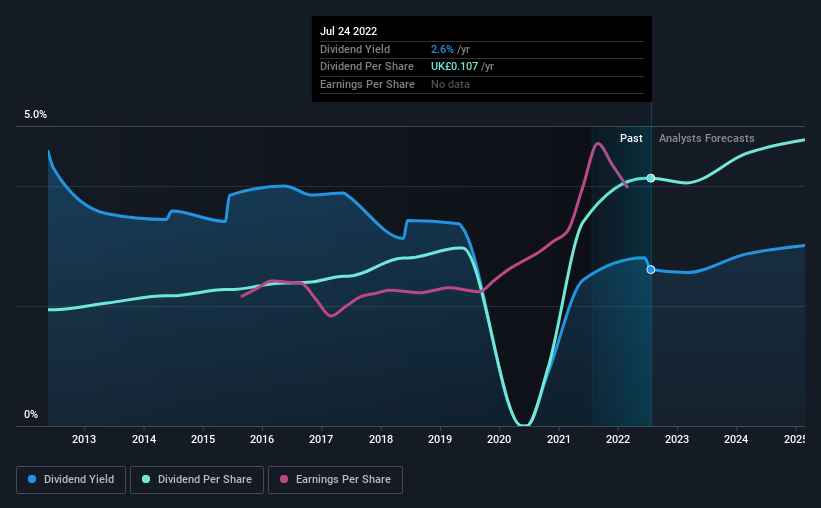Why You Might Be Interested In Bloomsbury Publishing Plc (LON:BMY) For Its Upcoming Dividend
Readers hoping to buy Bloomsbury Publishing Plc (LON:BMY) for its dividend will need to make their move shortly, as the stock is about to trade ex-dividend. The ex-dividend date is one business day before a company's record date, which is the date on which the company determines which shareholders are entitled to receive a dividend. The ex-dividend date is of consequence because whenever a stock is bought or sold, the trade takes at least two business day to settle. This means that investors who purchase Bloomsbury Publishing's shares on or after the 28th of July will not receive the dividend, which will be paid on the 26th of August.
The company's next dividend payment will be UK£0.094 per share. Last year, in total, the company distributed UK£0.11 to shareholders. Calculating the last year's worth of payments shows that Bloomsbury Publishing has a trailing yield of 2.6% on the current share price of £4.12. We love seeing companies pay a dividend, but it's also important to be sure that laying the golden eggs isn't going to kill our golden goose! So we need to investigate whether Bloomsbury Publishing can afford its dividend, and if the dividend could grow.
View our latest analysis for Bloomsbury Publishing
Dividends are typically paid out of company income, so if a company pays out more than it earned, its dividend is usually at a higher risk of being cut. Bloomsbury Publishing is paying out an acceptable 52% of its profit, a common payout level among most companies. Yet cash flows are even more important than profits for assessing a dividend, so we need to see if the company generated enough cash to pay its distribution. The good news is it paid out just 20% of its free cash flow in the last year.
It's positive to see that Bloomsbury Publishing's dividend is covered by both profits and cash flow, since this is generally a sign that the dividend is sustainable, and a lower payout ratio usually suggests a greater margin of safety before the dividend gets cut.
Click here to see the company's payout ratio, plus analyst estimates of its future dividends.
Have Earnings And Dividends Been Growing?
Companies with consistently growing earnings per share generally make the best dividend stocks, as they usually find it easier to grow dividends per share. Investors love dividends, so if earnings fall and the dividend is reduced, expect a stock to be sold off heavily at the same time. Fortunately for readers, Bloomsbury Publishing's earnings per share have been growing at 17% a year for the past five years. Bloomsbury Publishing has an average payout ratio which suggests a balance between growing earnings and rewarding shareholders. Given the quick rate of earnings per share growth and current level of payout, there may be a chance of further dividend increases in the future.
The main way most investors will assess a company's dividend prospects is by checking the historical rate of dividend growth. In the last 10 years, Bloomsbury Publishing has lifted its dividend by approximately 7.9% a year on average. It's encouraging to see the company lifting dividends while earnings are growing, suggesting at least some corporate interest in rewarding shareholders.
The Bottom Line
From a dividend perspective, should investors buy or avoid Bloomsbury Publishing? Bloomsbury Publishing's growing earnings per share and conservative payout ratios make for a decent combination. We also like that it paid out a lower percentage of its cash flow. Bloomsbury Publishing looks solid on this analysis overall, and we'd definitely consider investigating it more closely.
In light of that, while Bloomsbury Publishing has an appealing dividend, it's worth knowing the risks involved with this stock. For example, we've found 1 warning sign for Bloomsbury Publishing that we recommend you consider before investing in the business.
Generally, we wouldn't recommend just buying the first dividend stock you see. Here's a curated list of interesting stocks that are strong dividend payers.
Have feedback on this article? Concerned about the content? Get in touch with us directly. Alternatively, email editorial-team (at) simplywallst.com.
This article by Simply Wall St is general in nature. We provide commentary based on historical data and analyst forecasts only using an unbiased methodology and our articles are not intended to be financial advice. It does not constitute a recommendation to buy or sell any stock, and does not take account of your objectives, or your financial situation. We aim to bring you long-term focused analysis driven by fundamental data. Note that our analysis may not factor in the latest price-sensitive company announcements or qualitative material. Simply Wall St has no position in any stocks mentioned.
Join A Paid User Research Session
You’ll receive a US$30 Amazon Gift card for 1 hour of your time while helping us build better investing tools for the individual investors like yourself. Sign up here

 Yahoo Finance
Yahoo Finance 
